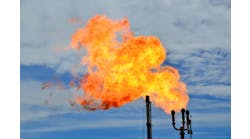THIS MONTH'S PUZZLER
Our refinery uses a thermal oxidizer (TOX) to dispose of vacuum off-gas. Currently, a steam jet pulls this off-gas because we've had reliability trouble with liquid ring pumps. We've suffered severe corrosion in the TOX's burners and tiles. Startup problems with the TOX — particularly with the fire detectors and igniter system — have caused delays. What's causing the problems and how can we improve the unit's reliability? We also have a related concern: our production manager wants to send the off-gas to a flare while the TOX is out of service for repair, which will take a week. The typical composition of the off-gas by volume is 30% H2S, 5% CO, 2.75% H2, 2.25% N2, 1% CO2, and 0.5% O2, with the remainder C1–C3 hydrocarbons. The vacuum is 40 torr, absolute, and the temperature is 120°F. About 2,500 pounds per hour would go to flare while the TOX is offline. Do we risk damaging our flare? What other problems might arise? What temporary measures would you suggest to avoid environmental issues?
CHECK SEVERAL FACTORS
Your problems could be related to your gas composition, corrosives' content and solids. Burner tips, when plugged, create misfiring and flame impingent. Burner tips' erosion from solids and corrosives also creates these. If you did not customize your TOX for your gas composition and make the internals as robust as possible to withstand your combustion (and corrosive) components, this is what would be expected. This is common with rental equipment.
Sending the off-gas to the flare while the TOX is out of service would be of concern to your reliability and environmental people. Environmental issues depend on your emissions permit.
Regarding damaging your flare, it would depend on what it was designed for (i.e., gas compositions/combustion products, corrosives in gas stream/combustion products). Flares are designed robust enough to withstand natural elements as well as common combustions products. Depending on the gas corrosiveness, robust metallurgies are selected.
A quick calculation using your 2,500-lb/hr gas and its composition plus C1-C3 (assuming 26.3% C1, 6.23% C2, 0.94% C2=, 23.08% C3 and 3.64% C3=) shows the following mass flows to flare: H2 4.5 lb/hr; O2 13.0 lb/hr; N2 51.3 lb/hr; CO 114.0 lb/hr; CO2 35.8 lb/hr; C1 320.6 lb/hr; C2 152.1 lb/hr; C2= 21.5 lb/hr; C3 829 lb/hr; C3= 124.9 lb/hr; and H2S 833.27 lb/hr. Using our flare efficiency and NOX efficiency program, we estimated the following emissions: NOx 2.42 lb/hr (NO 2.30 lb/hr and NO2 0.12 lb/hr); CO emissions would be 1.47 lb/hr and CO2 emissions 0.49 lb/hr. The amount of SO2 to the flare would be 1,568.5 lb/hr. The emission after destruction will depend on your flare destruction efficiency — compare the calculation against the permit to decide if you would incur permit violations.
As for the corrosion, some adjustment may be required. Our plant has three flares. Their service life span is 29 to 36 years. One services a gas stream that contains corrosive products. This one flare tip was changed 5 times. The last tip was re-designed.
Arbues Maymi, senior process engineer
CITGO Refinery, Corpus Christi, Texas
FIND A LONG-TERM SOLUTION
Let's start with the temporary permit required. You'll need such a permit when you install an amine system upstream of the flare. That should take care of any corrosion issues with the flare. There's no way you should run a stream with this concentration of H2S to flare; it's been done, though.
Another option is a stopgap TOX. As with all interim equipment, it will require a temporary operating permit. You'll probably also need to pass a stack test, so you'll want to plan for this during the repairs of the old TOX.
As for the liquid ring vacuum pumps, I would surmise the pumps failed because of contaminated seal fluid. Scale buildup eventually would cause a liquid ring pump to seize up. If hard enough, the scale could damage the bearings, seals and internal components. Vacuum pumps may be less reliable, and therefore, less suitable in this application.
Could there be a connection between the startup problems and the corrosion in the furnace? Perhaps, it's the flue gases. The SOx, formed by burning the H2S, could reach saturation in the brick or on the shell wall of the furnace. This would cause severe corrosion of the brick and shell — periodically necessitating wholesale replacement of the carbon steel plate. The effect of saturated acid gases, such as SOx, partially could be mitigated by selective insulation and even heat tracing. The idea is to reduce the penetration of the acid saturation point into the brick; you'd rather have brick wear away at the hot face than have acid worm its way to the vessel shell where it can cause permanent damage.
Likewise, the sulfur-tar residue formed in burning the gases could be fouling the fire detectors, giving false signals the burner pilot is off; the residue could choke the burner, adversely affecting the flow dynamics controlling mixing of the fuel and combustion air inside the burner tunnel. If the burner tile were severely corroded, enough to cause tile cracking, it would not act as a heat sink, allowing the fuel gas and air to heat to ignition temperature. In this type of situation, where damage may be unavoidable, reliability cost savings are in avoiding unanticipated catastrophic failures and by improving ease of repairs. Sometimes, redundant, isolated in-line spares might be a means to avoid fouling problems with fire detectors — controls alone are not the answer.
A search for a better material of construction should be weighed against the cost and long lead times of exotic materials, the learning curve of maintenance with new materials and techniques, compatibility issues, and cost of retrofitting. Sometimes, that cheap steel bolt that must be replaced in six months is a better choice than one of an expensive hard-to-find nickel alloy with an unpredictable reliability history. This same logic can be applied to cladding, which is another appealing option.
Dirk Willard, consultant
Wooster, Ohio
MARCH'S PUZZLER
Our refinery, which is located in the upper Midwest, runs into problems pumping liquefied petroleum gas (LPG) from storage bullets to tanker trucks during the summer. Except for low tank level, we can pump 600 gpm in the winter without any issues but have trouble pumping at all by late morning in the summer. That's when we divert propane, with some difficulty, to underground pipelines.
The bullet pressure reliefs are set at about 500 psig. The operating pressure starts at about 140 psig when the bullets are full but is only about 105 psig at about 45% full, which is as low as we can go. We feed four bullets at a time to the pump. During filling, pressure can spike at above 200 psig on a hot day.
Suction piping: the bullets have a single 4-in. discharge through a ball valve; flow is through about 150 ft of aboveground 8-in./10-in pipe. Discharge piping: two dryer tanks separate liquids from the LPG; there also are two filters and a strainer. (We haven't kept maintenance records for the dryers or filters.) A 600-ft aboveground run of 6-in. pipe goes from the 8-in. pump discharge to the flow control valve; a 2-in. hose connects the skid to the truck.
Typical loading of the rack, with 600 gpm, is at about 225 psig, immediately upstream of a 4-in. equal-percentage globe valve (CV = 220) with a final pressure of about 150 psig at the tanker truck. A turbine meter immediately upstream of the valve measures flow erratically. During startup, the flow is 100 gpm at 30 psig, with a pressure of 270 psig into the valve.
We need to address vapor lock of the valve during startup and pump cavitation during low level. We're seeing a one-year life on the seals in these multistage inline vertical LPG pumps. During the summer we always have trouble starting a pump once it has stopped. A manual vent line at the pump bowl connected to a flare is used to bleed off the gas. We always see a surge when we start the pump, hot or cold. There are secondary 2-in. lines at the top of each bullet for manually venting them to flare.
What is the cause of our pump problems? Would using a smaller valve help? What can we do to improve this operation?
Send us your comments, suggestions or solutions for this question by February 11, 2013. We'll include as many of them as possible in the March 2013 issue and all on ChemicalProcessing.com. Send visuals — a sketch is fine. E-mail us at [email protected] or mail to Process Puzzler, Chemical Processing, 555 W. Pierce Road, Suite 301, Itasca, IL 60143. Fax: (630) 467-1120. Please include your name, title, location and company affiliation in the response.
And, of course, if you have a process problem you'd like to pose to our readers, send it along and we'll be pleased to consider it for publication.


